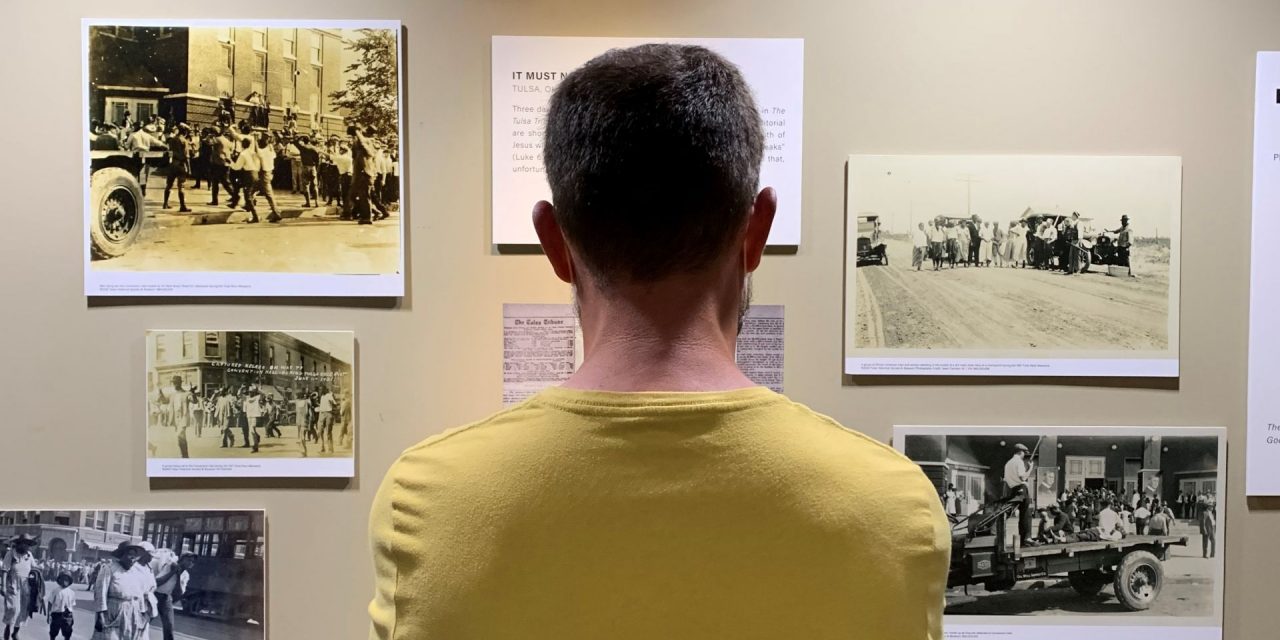Recently, I had the opportunity to visit the Tulsa Race Massacre Prayer Room at Tulsa, First.
If you have not been to this newly-established prayer ministry, I would encourage you to visit. It’s not a fun element of tourism, per se, but it’s a meaningful experience. The exhibit and prayer room will be open until June 1, 2021; Sunday, 8:30 am to 1:00 pm; Monday – Friday, 8:30am to 5:00 pm inside the church located at 420 S. Detroit Ave, Tulsa, OK.
As the Prayer Room website explains, “Its purpose is to provide a place for (Tulsa, First) and our community to explore the history of the Tulsa Race Massacre of 1921 and to prayerfully oppose the sin of racism in our world, in our churches and in our heart.“
The prayer room features a museum-quality exhibit with six stations, four of which provide an opportunity for prayer. As you progress through each station, you are presented with historical information and given the opportunity to pray with insight about the history and present realities caused by one of Oklahoma’s most tragic events. The entire presentation takes about 20-30 minutes to complete. What you encounter will challenge you, yet it is well worth your time and reflection to spend as much time as you need to process your thoughts and to pray.
- Expect to explore a history you probably didn’t learn in school
You will learn how on May 31-June 1, 1921 one of the nation’s most prosperous African-American cities—one that took years for its citizens to build—was destroyed in a matter of a few hours. The town boasted a library, 24 grocery stores, four drug stores, eight doctor’s offices, a dozen churches and more than 30 restaurants—all of these were all reduced to rubble.
Moreover, a still undetermined number of people lost their lives in the massacre, and an estimated 10,000* African American Tulsans were left homeless (*Source Wikipedia). You can find more of the history in this video (not part of the exhibit) which tells the story in brief.
- Expect to see a few explicit examples of racism
There are video clips and photographs from the time period on display, but perhaps the most illustrative of the racism of the time are the words found in examples of newspaper articles and letters written back then. You will read prose revealing the ugliness of racism found in a community from 100 years ago.
It was also sad to experience the sense of how uncomfortably contemporary and familiar some aspects of the spirt of racism of that time appear to be around even today. When a group of people of one race believes it’s their privilege to lord it over another, the words may be different, but the posture of bias and self-perceived privilege seems to remain.
- Expect to consider how even Christians can be infected with the spirit of racism
You will read the words of some of Tulsa’s white pastors of the time who harbored racism in their hearts and even dared to express their sinful views from their pulpits in the days after the event. It was heartbreaking to read and consider how Christian leaders can be absorbed in the worldly spirit of their age and harbor such hatred toward fellow humans for whom Christ shed His blood to redeem.
As I read the comments from these sin-tainted church leaders, I couldn’t help but think some of the things these people are saying are things you might read on Facebook today. People can use a lot of high-sounding arguments to justify their prejudices. It happened back then, and it’s happening today. It should not be so among Christian believers.
In the prayer room, you will also learn about one hopeful example that is worthy of imitation. But the real hope you will find in the experience is up to how much you allow yourself to be objective in learning from the experience.
- Expect to pray, confront your own biases and prejudices and consider how you can be a part of a better future
The entire presentation is very professional and of high quality, but the purpose of the experience is not merely to teach a much-needed lesson from history. The purpose is to drive Christians to our knees in prayer.
As hard as it will be to look at the images, read the words and consider the blight of racism, let it all soak into you and sit with it awhile when you are there. Perhaps you will experience, as I did, the truth that I also have need of repentance and restoration with others.
The prayer room is a place to lament the loss of a great community, repent of personal sins and pray for God to root out racism in your own heart. It is a place to become more spiritually sensitized to the purifying work of the Holy Spirit Who created all men in His image. Pray also that God will remove even the hint of racism from the church.
I, for one, am thankful that Tulsa, First Pastor Deron Spoo and other leaders put together this remarkable prayer room, and I highly encourage you to experience it for yourself.
“The Lord corrects the people He loves and disciplines those He calls his own” (Heb. 12:6 CEV).





